I’ve had to take a break from Land Rover activities for a while as I’ve been spending my weekends working on some essential major jobs on the house. My intention was to have this work completed over the winter but due to several bouts of bronchitis I lost a lot of time. The good news is that I will be outside working on Dilly again very soon, I have the parts ready to complete lots of work.
So this post is about an indoor job I did on my bass over a couple of evenings. It seems from looking around the web there are literally thousands of anorak-types like me who take an interest in every minute detail of this fascinating instrument that probably would have been consigned to history had it not been for Sir Paul McCartney.
Warning – what follows was written by an anorak for fellow anoraks, all rather sad!
Correct scale length – recommended strings for the Hofner Violin 500/1 Beatle Bass
See foot of page for info on scale length. There is so much incorrect information out there and strings are expensive.

I purchased my Hofner Contemporary Violin Bass a few years ago when playing in The Foot Tappers sixties band. I bought it because it looked right for that band, I had assumed before owning one that they were crap, just because people ‘in the know’ always told me they were. Well they certainly aren’t crap, they are a quality, loveable instrument, but very different to any other bass, and over the years I’ve owned at least a dozen bass makes and models. I guess the sound is limited compared to active basses and solid body instruments, they definitely aren’t suitable for slapping, but they are so light you hardly know you’re wearing it, and that special sixties tone cannot be imitated.
I did consider a German handmade version, they’re not cheap though at around £1,600 but if I really want gear I will always find the money.
Harley Benton copy
I had owned a cheap Chinese copy before and I found that at very high levels on stage, the hollow body would cause a boomy feedback. Unfortunately I found this out during a really important gig with The Peppermint Men at The UEA and for me it marred an otherwise memorable night.
I solved the problem by stuffing 16 bags of cotton wool through the pick-up apertures into the body. I remember that’s all that Boots had in stock at the Swaffham branch that day, and they seemed a bit bemused at me clearing the shelf. Although this worked, and actually gave that little plywood ‘Harley Benton’ bass a really lovely sound, it did change its dynamics. It may well be that the quality spruce that Hofner selects for its handmade instruments doesn’t suffer this way. When I see Sir Paul playing his 53 year old bass through that mighty Mesa Boogie system I wonder if it has been similarly dampened.
So, with this in mind, when getting the Hofner, I selected the more affordable ‘Contemporary’ model with its centre ‘sustain block’ that runs from the neck joint to the end-pin. I have played at huge volumes with this bass and although it retains the woody sound, I have never experienced any feedback problems.

I found this old photo of The Foot Tappers, not sure of the date but I remember the photo session very well. I was still using the Harley Benton / Boots the Chemist model then. I remember that Dave (centre) wasn’t very well that day, it was extremely hot in the home studio of the Cromer-based photographer. Here Mog has his 12-string Strat (another interesting instrument). Little did we know that day that poor Dave wouldn’t be with us for much longer.
Over the last couple of years I have depped with a variety of bands where a more modern sound and playing style was needed so I bought my excellent Ibanez SR500, which has a huge range of tones and is great for slapping too. Sound-wise, the Ibanez can do anything. The action, playability and refinements far exceed any other make I’ve owned. So the little violin bass was put away and forgotten about.
I seem to have fallen out of love with bass-playing of late and in an effort to generate some interest I thought I’d get it out again. After an hour of playing I decided to make some changes and give it a gig.
Changes
Replace the cracked pick-up ring
Change the machine heads to period, genuine ones
Acquire the period / correct Hofner ‘dog-lead’ strap
Change the roundwound strings to flats
Wiring mod
Package from Thomann
Thomann keep a good stock of Hofner parts, and a couple of days after ordering, a package arrived from Germany:
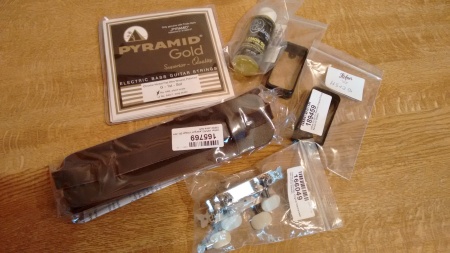
Pick-up ring
When I play this bass I end up resting my thumb on the top of the neck pick-up. It’s not very comfortable after a couple of hours as I can feel the grub screws that hold the pick-ups in place (a simple interference fit). These pick-up rings look to be up the job but I have cracked one before. It’s important to tighten these grub screws just right. Not so loose that the pick-up falls out but not so tight that it exerts undue pressure on the plastic. They are quite easily repaired with superglue / sanding / polishing the first time they break. As you can see I ordered an extra spare for future use.
GET THE RIGHT PART! Not as obvious as you’d think
Luckily I have been here before so I didn’t waste time and money as I had previously. The two pick-up rings on the Contemporary model are identical, they both use the BRIDGE pick-up ring of the German model. (The German model uses two types).
So, to replace either pick-up ring on the contemporary model you need the part ‘Höfner H512B PU Frame’ which is described as for the bridge position.
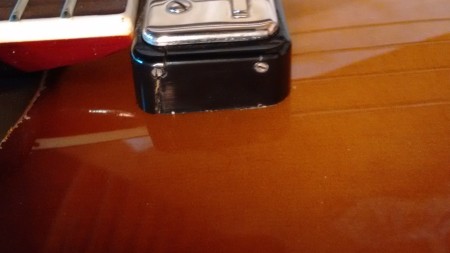
Replacement was easy, slacken the four grub-screws, lift out the pick-up (using Sellotape) and replace the ring, secured with two (supplied) screws. I shortened the two top screws so they could be slightly set in to the plastic and to lessen the gap between the pick-up and plastic (possibly the cause of previous failure). However, the screw holes still ‘annoyed’ my thumb during the subsequent gig and I have now come up with a better solution that I will detail in a future post when I have a spare half hour to try it.
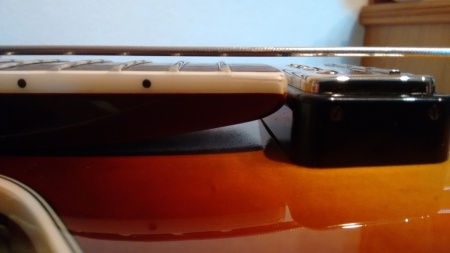
Note that since the above picture was taken, I have lowered the action by removing the adjustment wheels from under the bridge and replacing them with thin washers as shims.
For my playing style a thumb-rest would be ideal but this would wreck the look of the bass. Of course Sir Paul doesn’t have this problem as he uses a pick, resting his hand over the bridge.
Replacement of Machine heads (tuners) on the Hofner Contemporary Beatles Bass
As far as I know, the contemporary model enjoys the same hardware (pick-ups, bridge, trapeze) as its German cousin. The notable exception is the machine-heads. I understand that as this bass sold in greater numbers Hofner improved these but the ones fitted to my quite early example are Wilkinson and are CRAP, totally useless for a bass.
Famously, this instrument uses tuners designed for a six-string and the Wilkinsons just weren’t up to the job. They would slip and creak and were the only problem for me on an otherwise quality instrument. I know that Wilkinson are a good British company and I have used their components on other projects and been very happy with them, but not in this case.
The Foot Tappers were quite a busy band and soon after purchase I upgraded them to Grover Sta-Tites. These open backed machines are beautifully made and although not cheap I highly recommend them, they cannot be faulted from a practical point of view. Even on a bass (for which they aren’t designed) they are smooth, effortless and never slip. As they are designed for a six-string though, and come in sets, there are two leftovers.
BUT they don’t look right simply because they aren’t available with pearloid / plastic buttons and so I decided to try some genuine Hofner tuners.
As a side-note, if you are considering upgrading your bass with the Grovers, and I definitely recommend them apart from the visuals, you will doubtless have read that the fixing holes have the same spacing as the Wilkinsons. Well they do, BUT you will find that to line them up correctly with the edge of the headstock you will need to drill one additional hole for two of the tuners. To be correctly positioned, two of the original holes will JUST be visible. I’m not sure of the gear ratio now, but that too is perfect.


I know that the correct tuners for the 500/1 (1963) bass are separate open-backed tuners, and I almost bought those, but this would mean that the holes left by the Wilkinsons and subsequent Grovers would be visible. So I decided to risk a pair of the ‘strip’ tuners as used on McCartney’s first Hofner, the 1961 ‘cavern’ bass. I wasn’t sure if the peg-holes would line up but I knew the screw holes would be covered.
I was relieved and slightly amazed to find that the strip tuners do fit but it isn’t quite perfect. On one side the centres are exactly right but on the other they are very slightly out, but by less than 1mm. I suspect that this is a machining issue on my bass, later models may be more exact, I know that when I fitted the Grovers I used a different bush, and ideally a slightly tighter (internally) bush would be better for the Hofner tuners but that would reduce the tolerance in the shaft spacing.
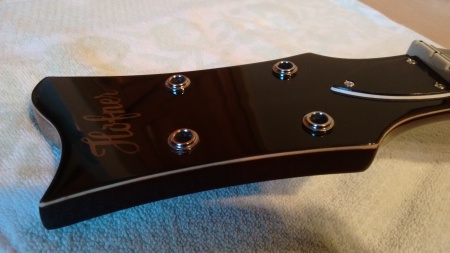
Filling the holes left by previous tuners
I think this is fairly standard practice. I used PVA to glue in cocktail sticks (only the best from Waitrose, Swaffham) carefully shaped to fill the holes and then sliced off with a razor-like blade.

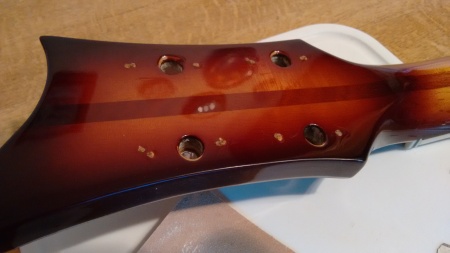
As the new tuners would cover these holes there was no need to stain / finish them. I carefully drilled new holes and attached the strips with 3 screws each side. The bearings are peened into the strips, with a sizeable (0.75mm) chunk of steel protruding from the underside. I didn’t want to let these in to the wood so they don’t sit perfectly flush.
Hofner strip tuners fitted – the verdict
Mmmm, well, I LOVE the look of them, they are tons better than the Wilkinsons, but I have been spoiled by the Grovers. It depends whether you value the look more than ease of use. I will definitely keep the Hofners on but they are nowhere near as smooth as the Sta-Tites. They keep in tune just fine though and seem up to the job for bass strings.
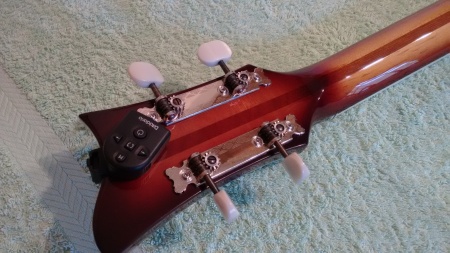
It wouldn’t be much of a job to go back if Grover were to add a pearloid version to their range, although one of the new screw holes each side wouldn’t be covered.
Strap
Normally with a strap, you just go for comfort and get a quality, wide strap. So that you don’t drop your pride and joy, you add one of the many strap-lock systems. Well this is what I’d done, but again, this quirky instrument throws in another problem. A locking button adds just a little extra spacing between the body and strap and due to the thickness of the instrument at the neck heel, it throws out the balance and the instrument tends to roll forward to face the floor.
I know that since he started re-using his Hofner after being rested for a few years, Sir Paul uses a conventional strap with locking buttons, but early on he used the famous ‘dog lead strap’.
The dog lead strap is fitted as follows: The end-pin is replaced by a small leather strip and large washer, this retains a steel D Ring to which the dog lead clips.
The neck end is completely different to anything else you’ll see. A longer leather strip is threaded through the gap between body and neck to form a loop, and this is tied to the strap with a leather string. It is this arrangement that creates the perfect centre of gravity thus alleviating the roll-forward problem. I experimented using string and decided to order the (expensive) Hofner dog-lead strap.

Well, although it is beautifully made, I shan’t be fitting this strap!
Edit: 24/12/2021
I have now fitted the strap and it’s great! I have some deps on bass coming up in the new year so I’ll be using the Hofner quite a bit. I found the strap at the back of my parts drawer a couple of weeks ago and thought I’d have a go at softening the leather. It was way too stiff and abrasive so I thought it would wreck the finish. I purchased a tub of ‘Universal Lederbalsam Leather Conditioner’ from Amazon and it did exactly what I wanted. The leather was instantly softened and is now pliable. I have fitted the strap following the instructions and can report that it balances the bass perfectly and no longer wants to tip forwards.
It has given me a template from which to make my own strap if I can source some soft leather.
D’Addario Elliptical End Pin
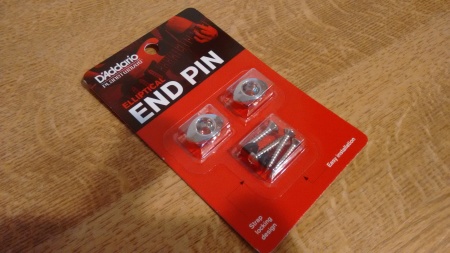
I found this ingenious but stupidly simple invention. I thought I’d tried every locking system known to man over the years. All of those fiddly and complicated locking systems now look plain silly. You fit this end pin so that it’s at right angles to the strap aperture in the playing position. That’s it, a five minute job. The strap sits against the instrument and all is good. However, for the neck end, I still want to take the strap point further forward if I can.
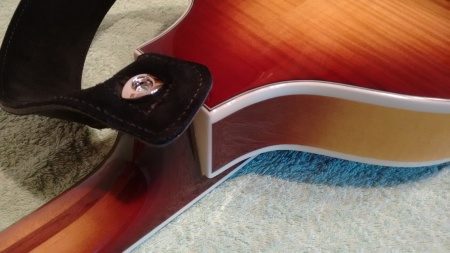
Lemon Oil
In my order from Thomann was a bottle of D`Andrea Lemon Oil. I have always used lemon oil to occasionally condition my rosewood fretboards, and I used to get it from a shop in Swaffham selling ‘essential oils’ to the alternative medicine trade. The D`Andrea stuff is much nicer, not quite so fragrant, but less sticky and slightly thinner. So as the strings were off I applied just a few drops and my fretboard looks and feels beautiful.
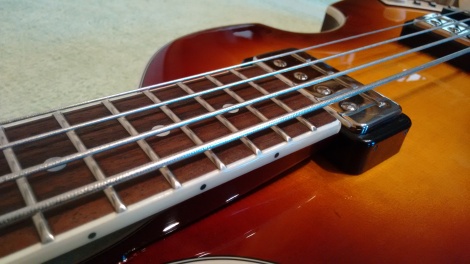
Strings for the Hofner Violin Bass 500/1
Scale length info further down…
Flatwound Strings
As I have another ‘general purpose’ bass, I thought I’d return the Hofner to an authentic sounding sixties instrument, and for this (although roundwound strings sound great), only flats will do.
I nearly bought a set of genuine Hofner strings, but at around £40 a set this just seemed to be a step too far. ‘La Bella’ are I believe what Sir Paul uses, but these too are expensive. I then read somewhere that Hofner’s strings are manufactured by ‘Pyramid’. I don’t know if this is true but that’s what I bought at a more reasonable £29.57. They are Pyramid Gold Flatwound – short scale*, gauges: 040-055-070-100 made especially for this bass.

Correct scale length
*Whilst the Violin Bass may technically be considered a ‘short-scale’ instrument, ordinary ‘short-scale’ strings will not fit.
This is a common misconception and you have to be careful if you buy strings by other manufacturers. The vibrating string scale length is actually 30″ but because of the trapeze / floating bridge arrangement and the fact that the wound section of normal bass strings won’t fit in the tiny machine heads, you need strings with 34″ of winding.
12-Sep-2017: I have added these notes to counter the wealth of misinformation out there:
Various bass forums, where new owners ask advice on this question, are often given a quick answer by some well-meaning person who doesn’t actually know the answer. In summary:
Long scale strings: Generally do NOT fit
Well, you may be able to make some makes fit, but due to the tiny tuners which are a similar size to those on a 6-string instrument, you will be trying to thread the full string thickness through the tuner post, resulting in fewer turns and an inflexible bend at least on the E and G strings.
Short scale strings: MIGHT NOT fit.
The wound portion of the string may not reach the nut, depending on the make of strings.
However, Pyramid Gold offer a ‘short-scale’ set that you can be confident will fit as they are advertised as ‘suitable for the Beatle bass’. That is what I fitted today and they are perfect.
Rotosound RS66S (Short Scale) definitely do NOT fit properly, the wound section is not quite long enough on all strings, so some will be sloppy in the nut. If like me, you like Rotosound bass strings use MEDIUM scale, e.g. RS66M which are a perfect round-wound choice.
Obviously if you can stretch to Hofner or LaBella strings, they are specified as being suitable for this instrument so you can’t go wrong.
Wiring Mod
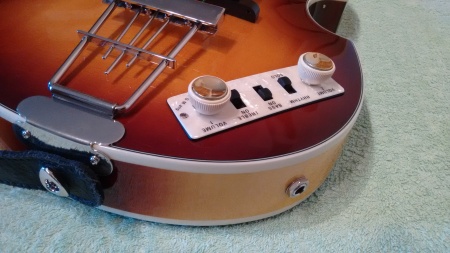
The Hofner control panel is well-known for its ‘quirkiness’, in my view, it is just that the switches are labelled incorrectly, or maybe wired ‘upside down’ and once you accept that, it’s easy. There is even an official Hofner video on YouTube where they explain why it’s right, but after making them this way for 60 years the video just makes it even more bizarre, as if Hofner are trying to convince the rest of the world that night is day. All this hardly matters.
What does interest me however, is that the tone capacitor is in circuit permanently. Having no tone pot, high frequencies are shunted to ground permanently. I wonder what tone capabilities are being lost and whether the addition of a tone pot would bring out a whole range of conventional tones.
Paul McCartney’s tone selection
It is very well-known that this musical genius, and in my view game-changing bassist is not at all technical, he simply isn’t interested in pick-ups, switches, wiring etc. He just gets the right sound and leaves alone, he even seems bored to talk about gear for more than a few seconds, he is a complete non-anorak.
He uses only the neck pick-up, the switches are kept in position with rolled up gaffer tape as seen in this superb video from a few years back, a pre-soundcheck interview with his technical manager Keith Smith:
At some point (possibly when the instrument was repaired by Mandolin Brothers of New York?) the control panel was refitted upside-down.


I guess that with talent at that level, it doesn’t matter what instrument you’ve got! He has used the same tone, from one pick-up for nearly everything.
Jazz Bass Wiring
I have decided to do a mod to make the controls work as a Fender Jazz bass (the instrument I favoured for years before getting the Ibanez), that’s a volume pot for each pick-up, no switches, and an overall tone pot. However, this mod must be easily reversible because it will change the look drastically. I have bought the components but (sorry!) will shelve the plan for a little while, I intend to fit some lightweight gold phono connectors inside the body to make it easy to switch control panels. I will also create a screened box from lightweight aluminium in which to house it.
I promise this will be done, and written up in the future.
Using the bass
With Kenny and The Motives, we returned to our New Years Eve venue at The William Burt Centre, Westwinch and had a great night, the punters here love to dance.
I must admit it felt like I’d got an old friend with me on stage and I really enjoyed playing it. I think it’s the first time I’ve used it live with my Phil Jones suitcase mini-rig and I was really pleased with the sound, it really gives that vintage vibe, a tight, melodic sound that you can feel in your chest.
I had forgotten how much output the Hofner pick-ups produce and a striking detail that I’d forgotten was that all notes on all strings appear to produce equal volume. Even when playing higher up the neck, and this bass somehow tempts that a lot, notes still have that full bottom end.
It really changed the whole sound of the band. Although the middle ‘quack’ of the Ibanez was absent, there was more bottom end, more bass. I was much louder than usual and kept with the soundcheck volume all night even though on stage it felt too much, I was assured by the normally ‘anti-bass’ Kenny that the mix was spot-on out-front. I think that the Ibanez possibly produces tones that are lower than audible so it gives the impression that it’s too loud.


Either way, it was a nice change and I will go with it for now.
Thanks for making it this far!
Fantastic blog Nige! I have read it all thru with interest and it may inspire me to change the original 60s tuners on my Precision to make it usable again. Pleased you got the full flat wound sound at the gig – I reckon the flat wound mid low thud takes the bass into its own space in the soundscape an avoids competing with guitar.
LikeLike
Thanks Mog! Yes, it’s certainly a different tone, easier on the fingers too, I can’t see anyone getting blisters using these. Looks like Gotoh makes tuners for your wonderful Precision bass.
LikeLike
Really interesting post – even for a non-anorak like me 🙂
LikeLike
Thanks Simon! Especially nice that even a non-anorak like you appreciates it, er yes, OK…. 🙂
LikeLike
Non Anorak in terms of guitar set up you understand – I’m anorak enough on other subjects 🙂
LikeLike
Very interesting that you are having much the same thoughts as me (or me as you!) about this bass. I have the cheaper Indonisian version, but it still applies. The wiring! Yes! I fixed mine up so that i have overall volume, one switch for bridge pickup on/off, (i want to mute the bass quite often, without effecting the other settings between sets, other pot is neck volume then a tone cut switch and finally a switch to change the tone cut capacitor (a bit of rounding off or quite muffly). All this means i dont have to get a new control plate. You might consider this a a possible compromise towards jazz bass capabilities. Anyway now looking at better ratio heads… its so hard to tune quick! All the best James
LikeLike
Thanks James for your interest and ideas, sounds like you’ve got the controls working well for you. I’m playing the bass as it is for now and loving it, but will no doubt get back to it when I get bored. I have another Hofner wiring project going on now that I’ll write up soon, I have acquired a Contemporary Club 6-string guitar that will be rewired shortly. All the best and thanks for your support, Nigel.
LikeLike